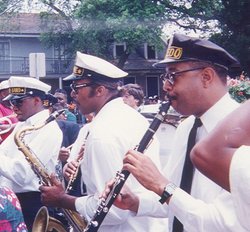Jazz funeral
A Jazz Funeral ( English : jazz funeral ) is a musical funeral rite , originally in New Orleans has emerged.

In the early 20th century, the custom of the jazz funeral spread across New Orleans' ethnic boundaries. When brass band music grew wilder in the years leading up to World War I , some New Orleans “whites” viewed the music as disrespectful. As a result, such musical funerals were rare among residents of European descent. By the mid-20th century, the Roman Catholic Church officially disapproved of secular music at funerals. Because of this, for many generations, the tradition was practiced almost exclusively by African-American Protestants in New Orleans. After the 1960s, jazz funerals slowly spread across ethnic and religious lines. Most often such musical funerals are organized for musicians, people from the music industry, members of social clubs or members of the carnival parade.
The funeral organizers are responsible for finding and hiring a band. When a respectable musician or well-known member of the community dies, additional musicians usually play during the procession to show their appreciation.

A typical jazz funeral begins with the funeral procession of family, friends and a brass band from the house of the deceased, the funeral home or church to the cemetery. During the entire procession the band plays dark laments and chorales . The tone of the ceremony changes when the deceased has been buried or the hearse has left the procession and the relatives have said goodbye to the deceased for the last time. After that, the music becomes more cheerful. Often a chorale or a spiritual piece in a swing version is played first. Well-known rhythmic melodies follow. There is noisy music and cathartic dances. Onlookers join the festival community to celebrate the life of the deceased. Those who just follow the band to enjoy the music are part of the so-called " second line " and their style of dancing, marching along and sometimes waving an umbrella or handkerchief in the air, is known as "second lining".
Some younger funk and hip-hop- oriented brass bands often play almost no lamentations and chorals or only play the traditional song Just a Closer Walk with Thee .
Another song that sometimes sounds during the happier part is the New Second Line march, which was played during the jazz funeral in the James Bond film Live and Let Die .
Known people who received a jazz funeral
See also
Web links
- Let Me Do My Thang: Rebirth Brass Band (English)
- Love and Death at Second Line (English)
- The Jazz Funeral (English)